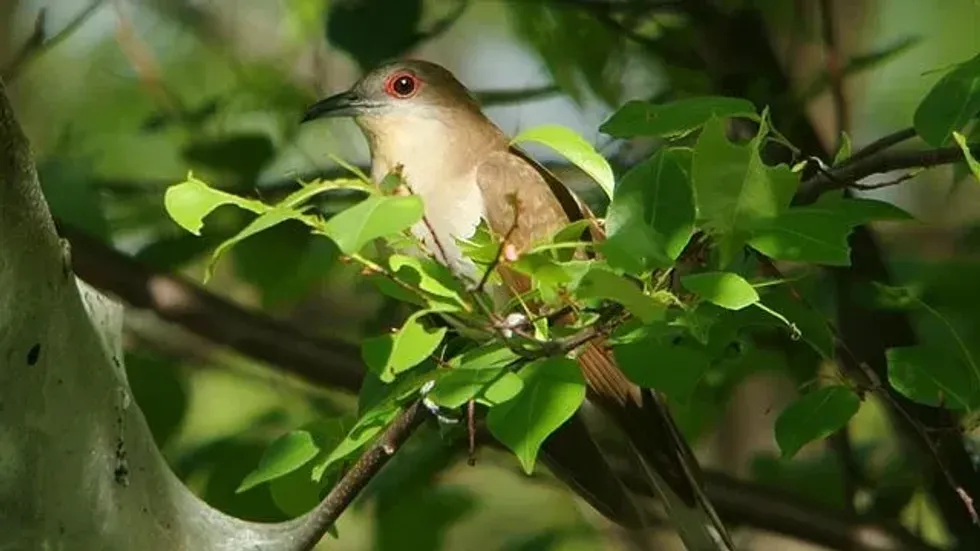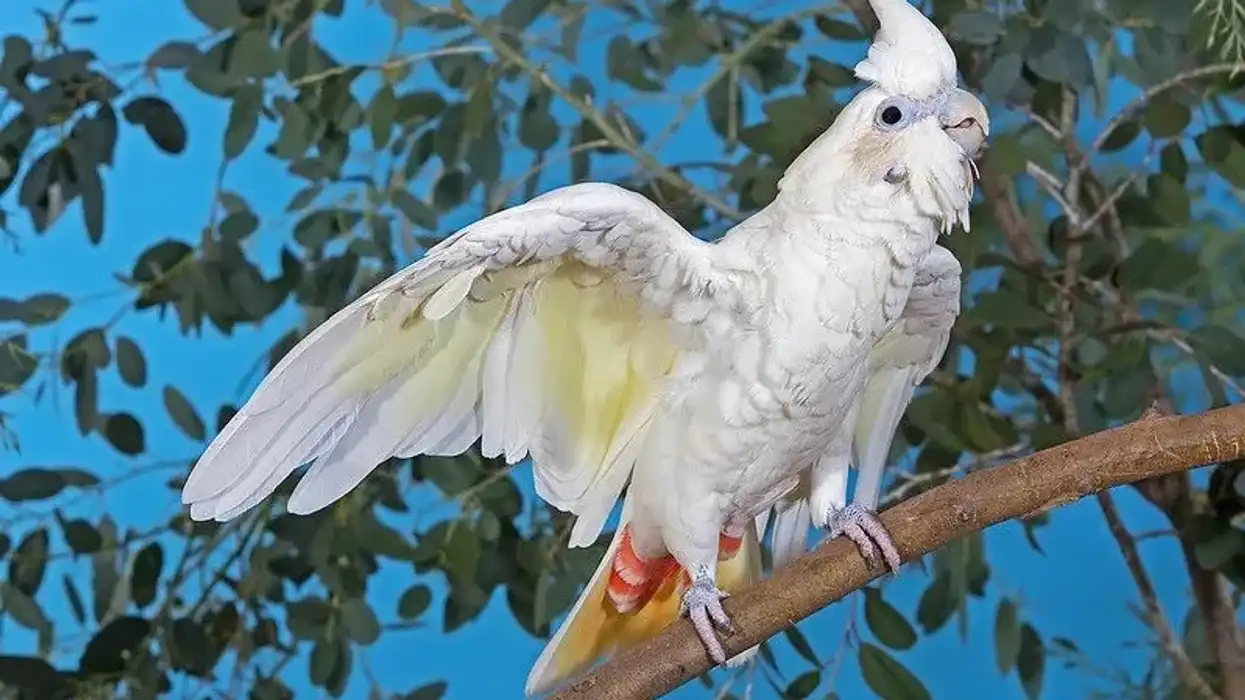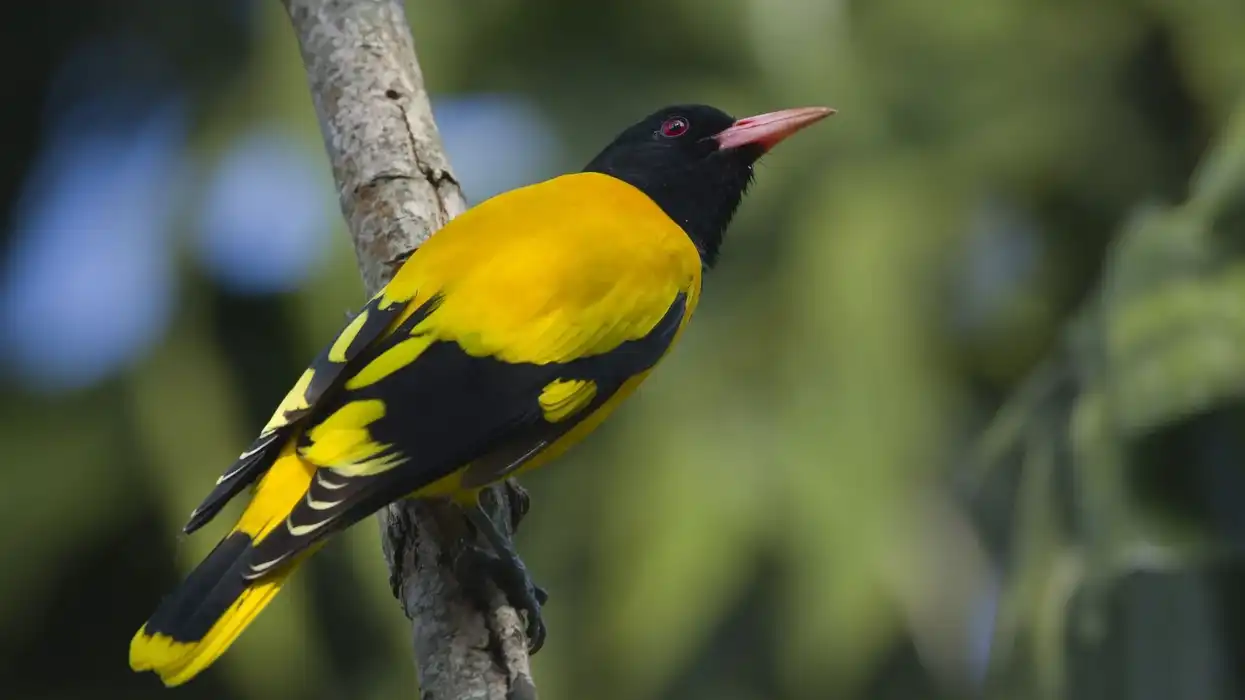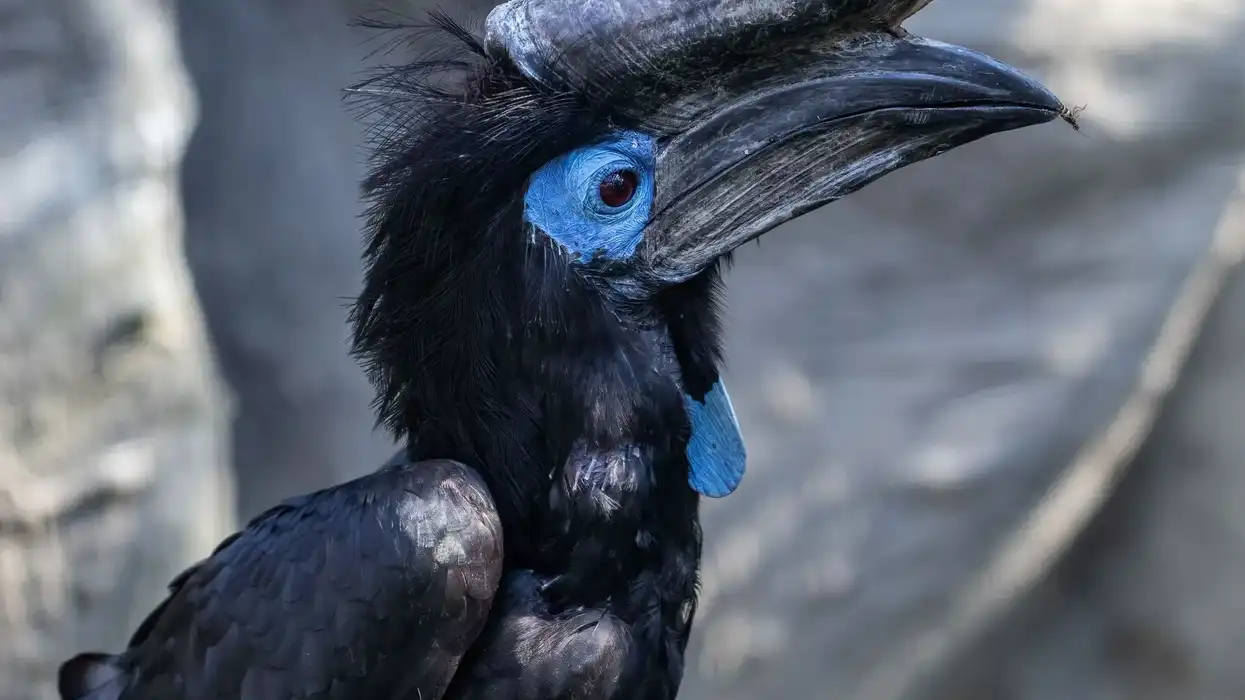The black-billed cuckoo (Coccyzus erythropthalmus) is one of the New World species of birds of North America (order Cuculiformes, family Cuculidae). These North American birds are distinguished from a similar species of bird, the yellow-billed cuckoo, by the color of the bill.
While the former has a dark-colored bill, the latter is a distinct shade of yellow. However, the habitat of the closely related species of black-billed and yellow-billed cuckoos overlap significantly.
The black-billed cuckoo (Coccyzus erythropthalmus) has its scientific name rooted in two ancient Greek terms, 'kokkuzo', meaning 'to call like a common cuckoo', and 'erythropthalmus', which is a fusion of 'eruthros', meaning 'red' and 'ophthalmos', meaning 'eye'.
Sneaking through leafy thickets and forest trees, the secretive black-billed cuckoo is quite difficult to spot and is way more furtive than yellow-billed cuckoos.
The thickets conceal them perfectly, and they are more often heard than seen with their characteristic cuckoo call or song with soft and repeated series of 'coo-coo' notes.
If these North American birds interest you, go ahead and read more about the black-billed cuckoo (Coccyzus erythropthalmus). Want to read more about other intriguing birds? Then check out facts about green parakeets and yellow-billed cuckoos.
Black Billed Cuckoo Interesting Facts
What type of animal is a black-billed cuckoo?
A black-billed cuckoo (Coccyzus erythropthalmus) is a North American bird species of the family Cuculidae and order Cuculiformes.
What class of animal does a black-billed cuckoo belong to?
Black-billed cuckoos belong to the class Aves which includes all birds.
How many black-billed cuckoos are there in the world?
While the global population of the common cuckoo species is estimated to be around 25 to 100 million individuals, there is no data regarding the exact population of black-billed cuckoos. However, according to the International Union for Conservation of Nature (IUCN), black-billed cuckoo birds have a decreasing population trend.
Where does a black-billed cuckoo live?
This species of black-billed cuckoo lives in a wide range of habitats but mostly inhabits dense woodlands and wetlands. They mostly inhabit forests with evergreen and deciduous trees, thickets, and orchards located near a source of natural water, such as a stream, river, or lake.
This elusive species of bird of North America is also frequently seen in suburban and urban locations such as parks and golf courses.
What is a black-billed cuckoo's habitat?
Black-billed cuckoos are primarily forest dwellers. Their habitat is predominated by dense woodlands and forests with an abundance of trees and thickets.
In North America, the range of black-billed cuckoos spans most of the United States but hardly extends into the states of Tennessee, Oklahoma, Arkansas, and North Carolina. They are also found in western Nova Scotia, eastern New Brunswick, Prince Edward Island, and the southern regions of Quebec, Ontario, Manitoba, Saskatchewan, and Alberta.
During the fall, these species of birds migrate to Central America and northern South America, where they can be found in Bolivia, Columbia, and Venezuela. Besides North America and South America, the black-billed cuckoo species is also an occasional vagrant in Greenland and Western Europe.
During the migration season, this species of bird are seen foraging in woodlands, thickets, scrublands, gardens, and orchards. The birds also use a similar habitat on their wintering grounds. Their wintering grounds in South America mainly consist of deciduous woodlands, tropical rainforests, or even a scrub forest.
Who does a black-billed cuckoo live with?
The black-billed cuckoo species of birds are primarily solitary but form monogamous pairs during the breeding season. These birds are also seen in pairs during the migration season.
How long does a black-billed cuckoo live?
Black-billed cuckoos of North America have an average lifespan of five years in the wild.
How do they reproduce?
Black-billed cuckoos are thought to be monogamous, meaning that they have one mating partner. The breeding season stretches from May to September, during which male and female birds of a mating pair build nests made out of pine needles, leaves, and empty cocoons. The nests are built in thickets or groves of trees, concealed enough from view.
Mating is preceded by a peculiar behavior during which a male bird lands on a branch close to a potential female mate with a food material (such as insects) held in its mouth. This is followed by the male giving out a 'coo-coo-coo; call and the female responding with a 'mewing' call.
The female then does a typical tail flicking, during which the male sits motionless.
After mating, female black-billed cuckoos lay about two to five eggs which undergo incubation for 10 to 11 days. The eggs of black-billed cuckoos are greenish-blue in color and often appear marbled.
After the incubation period is over, the eggs hatch with the young birds leaving the shell with a low call. Hatching of the eggs of black-billed cuckoos occurs during the early morning. It takes minutes after hatching for the young birds to become alert and active, and they leave the nest in about 17 days.
What is their conservation status?
Black-billed cuckoo birds are classified as being of Least Concern in the International Union for Conservation of Nature (IUCN) Red List of Threatened Species.
Black Billed Cuckoo Fun Facts
What do black-billed cuckoos look like?
Black-billed cuckoos are slim and slender birds with a hunchback posture when perched. They have a very long tail and a slightly downward curving black bill.
The body and upper part of the head are covered with plain brown feathers, but the underside is completely white, providing a sharp contrast against the rest of the brown plumage. The tail feathers are brown as well, but their underside is grayish with small black and white tips.
The eyes of full-grown black-billed cuckoos have a red ring around them.
Young black-billed cuckoos have a similar appearance, except that their eye-ring is yellowish or buff-colored, and their underside is more cream-colored than white. A yellow-billed cuckoo is more or less similar looking to black-billed ones in terms of color and body shape. However, the former's lower mandible (bill) is yellow, and the wings are reddish-brown.

How cute are they?
The compact and slender body of black-billed cuckoos makes them look quite cute, especially when they are perched with a hunched posture.
How do they communicate?
Although black-billed cuckoos are very elusive and spotting them may need a rare stroke of luck, these birds are very vocal, and their characteristic call can be heard quite clearly even from a distance. The call sounds like 'coo-coo-coo-coo', heard as a rapid, repetitive, and high-pitched sound.
A couple of days old chick produces a buzzing sound like that of an insect, and when about a week old, they emit a barking call. Pre-mating courtship is marked by a 'coo-coo' call from the male and a 'mewing; call from the female.
While daytime calls can be heard during the breeding season, black-billed cuckoos mostly call during the night in mid-summer. These birds are capable of producing up to six different types of sounds, each for a particular social condition.
The sound of a cuckoo is known to represent good luck and a symbol of hope. If you hear a cuckoo, it is supposedly a sign that something good is coming your way. You are also meant to run in a circle three times for good luck when you hear the first cuckoo call in spring.
How big is a black-billed cuckoo?
The standard length of a black-billed cuckoo ranges between 11-12.6 in (28-32 cm) with a tail length of 5.8-6.2 in (14.7-15.7 cm). Black-billed cuckoos are almost the same size as yellow-billed cuckoos.
How fast can a black-billed cuckoo run?
Black-billed cuckoos are birds that are either found perched in trees or flying. They hardly ever run.
How much does a black-billed cuckoo weigh?
The average mass of black-billed cuckoos ranges between 1.6-1.9 oz (45-55 g).
What are the male and female names of the species?
Male and female cuckoos do not have any distinct names. They are usually called a male black-billed cuckoo and a female black-billed cuckoo.
What would you call a baby black-billed cuckoo?
A baby or young black-billed cuckoo may be called a chick, nestling, or hatchling.
What do they eat?
Black-billed cuckoos are omnivorous, and their diet primarily consists of insects such as grasshoppers, beetles, crickets, butterflies, stink bugs, dragonflies, katydids, cicadas, and tent caterpillars. In addition, they may also feed on the egg of birds, fish, aquatic larvae, moth larvae, snails, fall webworms, fruits, seeds, and berries.
Are they dangerous?
Black-billed cuckoos are not at all dangerous and are not known to show any aggressive behavior toward humans. Members of their population are so elusive that they can hardly ever be spotted.
Would they make a good pet?
Black-billed cuckoos are wild birds and are not suited for keeping as pets. Besides, keeping these birds as pets is illegal in many places.
Did you know...
Known predators of black-billed cuckoos are raccoons, arboreal snakes, falcons, hawks, common grackles, and blackbirds.
Brown-headed cowbirds and yellow-billed cuckoos are brood parasites that have been reported to lay their eggs in the nests of black-billed cuckoos.
Common host birds of the black-billed cuckoo are yellow-billed cuckoos, American robins, wood thrushes, gray catbirds, and chipping sparrows.
Black-billed cuckoos are a protected species under the United States Migratory Bird Act.
Are cuckoos rare in the UK?
No, cuckoos are not rare in the United Kingdom. Several species of cuckoos are found throughout the United Kingdom, especially in central and southern England.
What is special about a cuckoo?
Besides the typically high-pitched and repeated 'coo-coo' call of cuckoos, what sets these birds apart from others is that they are brood parasites. These birds will generally make their nests out of pine needles and twigs and lay eggs in them.
However, during times when there is plenty of food available, cuckoos engage in brood parasitism, meaning that they lay their eggs in the nests of other bird species, which in turn act as foster parents for the cuckoos' young ones instead of caring for their offspring.
Such foster parents or hosts are mostly small species of songbirds. What is interesting is that a female cuckoo lays eggs that are strikingly similar in appearance to the egg of the host species. The host birds fail to recognize the foreign eggs and take care of them like their own in their nests.
Here at Kidadl, we have carefully created lots of interesting family-friendly animal facts for everyone to discover! Learn more about some other birds, including northern bobwhite or eastern meadowlark.
You can even occupy yourself at home by drawing one on our black-billed cuckoo bird coloring pages.









